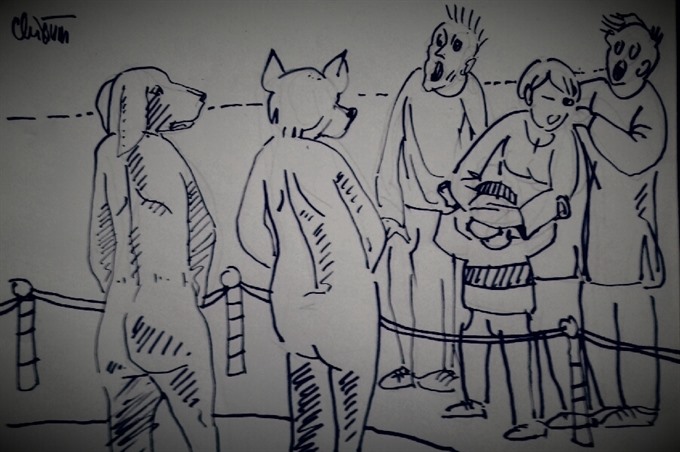 Talk Around Town
Talk Around Town

Last weekend, my sister Linh took her kids to visit the Hòn Dáu Resort in Đồ Sơn. They had a good time till they walked into the resort’s garden of statues.
 |
By Chu Lan Hương
Last weekend, my sister Linh took her kids to visit the Hòn Dáu Resort in Đồ Sơn. They had a good time till they walked into the resort’s garden of statues.
Her sensibilities were offended by the 12 statues with heads of various animals attached to naked human torsos with their genitals, male and female, explicitly sculpted and “exposed”.
“When my 4-year-old daughter pointed at the statues’ genital organs and curiously asked me ‘what are these’, I felt really embarrassed. I also found them vulgar. I could not get her out of the place quickly enough.”
Linh’s discomfiture, disgust even, is shared by many people.
“I do not understand why they (the sculptors) made the statues’ genital organs so graphic”, said Quang, a 40-year-old man in Hà Nội. He was also not impressed that the faces of the animals were not easily recognisable, requiring identification plaques to be placed at the foot of the statue.
“I did not find the statues beautiful,” said Quang, continuing to vent his ire, “and worse, it has bad effects on children.”
In his defence, the resort director said the garden of statues was established in 2007 and the sculptors commissioned were famous Vietnamese and foreign artists. The statues represented fertility in art, he said, adding that they had been standing for more than 10 years without drawing any complaints.
Now that they have drawn some complaints and stirred up a controversy, the issue of artistic licence can be examined or re-examined.
Well-known painter Thành Chương told online newspaper dantri.com.vn that paintings and sculptures of nudes have been part of cultures worldwide for a long time.
In many regions of Việt Nam, people worship the fertility symbols of linga and yoni, he noted, but added: “Although they worship the symbols publicly, no one feels offended because the symbols are very artistic and occupy appropriate cultural spaces”, the painter said.
“I looked at the statues in Đồ Sơn very carefully and I did not find them very artistic. I felt offended. This was a stupid idea,” he said.
I share his aesthetic rejection of the statues, not finding them very appealing, but that is also a personal opinion.
But, while many people have called for the statues to be removed, there is also support for the display, in terms of freedom of expression as well as appreciation of the idea behind it.
A Facebook account named Khoa said that the statues were “normal”, expressing “fertility in art”.
It is also normal that children are curious, and parents should use the curiosity (about the statues) as an opportunity to provide some gender education instead of “running away”, he said.
The resort’s owner has also said that he is very disappointed about recent reactions from some members of the public. The statues have been there for several years and visitors have been happy to pose for photos with them, he said.
“There were no complaints about them (for a long time),” he said expressing surprise that just a few photos posted on some social networking sites have triggered a wave of criticism.
It is understandable that the owner feels aggrieved, but his being “forced” to cover the private parts of the statues with assorted pieces of underwear has turned the place into an ungainly, ugly joke.
And the joke is on all of us, too. It is not just the statues that look silly, we, as a society, look silly.
We live in a world where age-old societies have celebrated nudity, even considered it sacred. How can one take offense at sculptures of the Apsaras in Angkor Wat and other places? What about the temple in India where various sexual positions mentioned in the Kamasutra are carved? Many nude sculptures are known and admired all over the world.
In Việt Nam, we have appreciated artists who have specialised in nude photography, and just about every student of painting learns to paint nudes.
Painter Vi Kiến Thành has criticised the statues as not being artistic and not carrying any message for viewers. Such criticism is valid. We can object to the aesthetics and hope for more pleasing, meaningful artwork that involves nudity, but saying sculptures, or other works of art, have to be removed because they are nude is not okay.
If, as my sister Linh says, she finds the statues “ugly and vulgar”, she, and others who feel the same way can simply avoid going to that “garden” again.
The naked truth is that we are all born naked, and the shame and other negative connotations about open displays of nudity are just conditioned responses.
And it is only fair to lend our ears to the man whose idea these statues were, in the first places, sculptor Trần Minh Tuấn.
He told vietnamnet.vn that his perspective was that his work is an appreciation of the beauty of bodies “given to all of us by The Creator”.
Furthermore, sculpting “true” genital organs was normal for art works, and could not be called “vulgar,” Tuấn said.
Some people objecting to the statues might not have had the chance to know this kind of art, he said, noting that ancient Greek and Roman cultures describe gods and goddesses with animal heads and human bodies. Five centuries ago, there were Vietnamese sculptures depicting different positions in sexual intercourse, and expressions of fertility in art was a global tradition, he said.
“Thus, I want people see the statues as artworks.” — VNS




